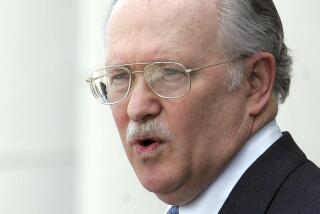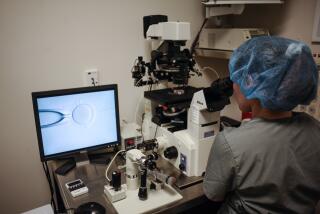Baby Fae’s Legacy: High Hope and a Quiet Hero
- Share via
NEW ORLEANS — Church convention-goers in the Superdome watched giant television screens as tiny Baby Fae stretched and yawned during her nearly three weeks with a baboon’s heart and as her surgeon, Dr. Leonard Bailey, talked about the historic transplant.
Any Seventh-day Adventists absent for that videotaped program during the 54th world conference here could stop by the Loma Linda University exhibit booth to view another video presentation of the Baby Fae story and pick up a 192-page compilation of news clippings about the operation last Oct. 26.
The first primate-to-human transplant with an infant was performed at the Loma Linda University Medical Center, 60 miles east of Los Angeles, on a premature baby suffering from the always-fatal hypoplastic left heart defect. The girl died 20 1/2 days later from unknown causes.
The event has had two important effects in Adventist churches: Bailey has become a quiet hero for a small denomination seeking greater visibility, and the church’s approval of Bailey’s work gives the surgeon and his staff the kind of backing needed to do more cross-species transplants.
Several church leaders here have acknowledged that if Adventists were bitterly divided over the ethics or biblical warrant for implanting baboon hearts in humans, it would be difficult to continue the work at an Adventist hospital.
It is now evident that in the months since the operation, the traditionally health-oriented Adventists seem generally satisfied that initial questions were answered about parental consent, medical alternatives and religious considerations.
Not only that, but many church members appear proud that an Adventist doctor performed the surgery in an Adventist hospital.
“I was very pleased that we were on the frontier of this,” said Fairra Roddy, a nurse-anesthetist from Nashville, Tenn., who typified comments here.
Roy Branson, an ethicist with the Kennedy Institute at Georgetown University and editor of an Adventist journal, said the Baby Fae transplant was the biggest news involving Adventists since their beginnings in the mid-1800s.
More than a medical innovation, Branson said, “it is also a moral statement, an embodiment by Adventist physicians of moral and religious values.”
The Adventist Health Systems is emerging as perhaps the largest nonprofit health care system in this country, Branson said, and if Adventists meet ethical standards in medical matters, “Baby Fae may come to be known as a turning point in not only American medicine but also in the Adventist Church.”
The public attention given to the Baby Fae case last fall was significant for Adventists, said television evangelist George Vandeman of Thousand Oaks. “We’re an unpopular people because of the uniqueness of some of our beliefs,” he said.
Seventh-day Adventists are like conservative Protestants in opposing smoking, drinking and gambling and in believing in the imminent second coming of Jesus and in a creationist view of the world.
Their Saturday Sabbath, vegetarian diet and some biblical interpretations inspired by Ellen White, considered a 19th-Century prophet, have usually set them apart from the rest of Protestantism.
As a result of the Baby Fae surgery, the 41-year-old surgeon, whose mustache and graying hair impress many as distinguished-looking, has become a quiet hero for Adventists.
With a modesty considered becoming among Adventists, Bailey has avoided the public press and virtually confined his interviews and talks to the Adventist and scientific communities. Bailey was not asked to speak here, but he did accept an alumnus of the year award last spring from Columbia Union College in Takoma Park, Md.
‘My Little Girl’
The interview with Bailey shown to delegates here was originally part of the Adventists’ “It Is Written” program hosted by Vandeman and aired last May.
Bailey has been candid in discussing the operation and his feelings about it with fellow Adventists. Explaining why he often stayed overnight at the side of Baby Fae after the operation, Bailey said, “She became my little girl, much like she was to the nurses and staff.”
Bailey said the Barstow mother of the girl “was probably one of the more perceptive people I’ve dealt with as a parent (and) able to make a decision under pressure.” The Baileys have maintained contact with the mother; “she and my wife talk regularly,” he said.
In a two-part “as-told-to” article for the Adventist Review, Bailey said he broke his own rule of never going to the funerals of patients by attending the small private service for Baby Fae. He also reflected on some of the criticism that arose with news of the transplant, including objections from animal rights activists:
“It was interesting that following the Baby Fae operation, ethicists came out of the woodwork screaming and hollering as if we had not given any thought to what we were doing. Yet it’s been something that we’ve thought about and wrestled with philosophically all the way along, because we knew where we were headed.
‘Best for Human Beings’
“The whole concept of Christian ethics is based on humanness--what is best for human beings. The moral or ethical argument isn’t really sound when we begin to say that the baboon has greater rights than the dying human baby.” (Last May, Bailey canceled a speech at a University of California, Irvine, medical class when he learned that the talk was to be public and was attracting animal rights protesters.)
Some letters published earlier in the Adventist Review had criticized the cross-species transplant. “A baboon’s heart belongs in a baboon,” one Californian wrote.
An Adventist official based at the church headquarters in Takoma Park cited both biblical verses and lines penned by White in another letter objecting to the operation.
“Even though convincing arguments can be put forward in favor of gene-altering or surgical procedures that seek to blend human and animal flesh for the benefit of humanity, it appears that God forbids such interference with His laws,” wrote Ernest H. J. Steed.
The “amalgamation” of animal and human flesh that White spoke against is not applicable because a woman with a primate’s heart would not pass along a primate’s genes, said a letter from Harry A. Van Pelt of Fresno.
“The purpose of Baby Fae’s surgery was to give a baby without a chance for life a chance--if ever so small,” Van Pelt wrote.
Not Serious Obstacles
The religious and anti-vivisectionist objections have not been serious obstacles to the plans of Bailey and his colleagues to do five more transplants on babies.
Of more concern are questions from the medical profession. The Journal of the American Medical Assn. is expected to publish the Loma Linda team’s report on the case.
“Some people will try to pick it apart, but they’re going to have an awfully hard time,” Bailey said in the Adventist Review articles published in late March.
Spokesman Dick Schaeffer of the Loma Linda University Medical Center recently said it would be three months to a year before the next transplant would be performed. In May, immunologist Sandra Nehlsen-Cannarella, who worked with Bailey on the operation, told a medical weekly that no more baboon-to-baby transplants were planned until the cause of Baby Fae’s death is resolved.
Schaeffer also said that Bailey must also gain approval for the next transplant from the university’s institutional review board. “It’s not going to be a rubber-stamp decision,” Schaeffer was quoted as saying.
Nevertheless, Dr. Richard L. Sheldon, chairman of the review board, recently indicated that consent form objections raised in a generally positive report of the Baby Fae case by the National Institutes of Health have been since satisfied, including the most-mentioned objection, that a human heart was not sought.
Other Babies Die
Sheldon said that at the time his writing (to the independent Adventist journal Spectrum), two infants with hyposplastic left heart syndrome have died at the Loma Linda facility. In the six months after Baby Fae’s death on Nov. 15, Sheldon estimated that 150 infants in the United States would have been born and died with this congenital disorder.
“There have been no reported human hearts available to this entire group, nor have there been any made available for Loma Linda surgeons to transplant through the Regional Organ Procurement Agency,” Sheldon said.
“Human size-matched, immunologically compatible hearts would be preferable,” and the Loma Linda review board will require the surgery department to search for human hearts, but Sheldon said he expects it to be futile. He also posed the question of how ethical it would be to allow the patient to linger near death while a fruitless search continued.
More to Read
Sign up for Essential California
The most important California stories and recommendations in your inbox every morning.
You may occasionally receive promotional content from the Los Angeles Times.













